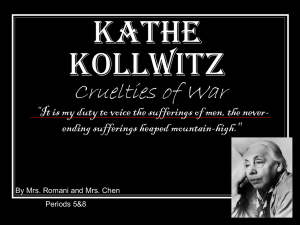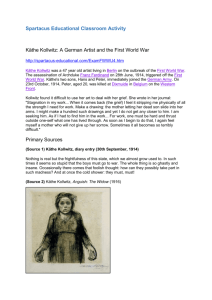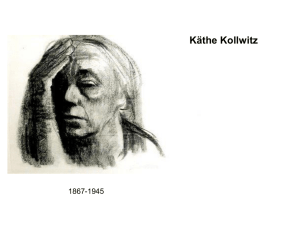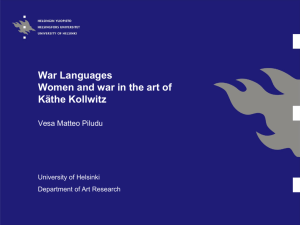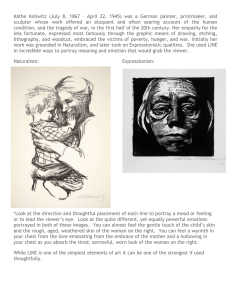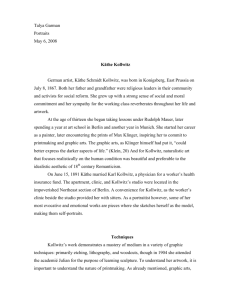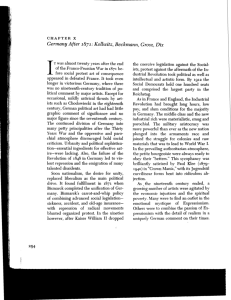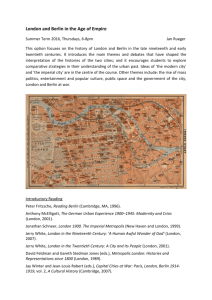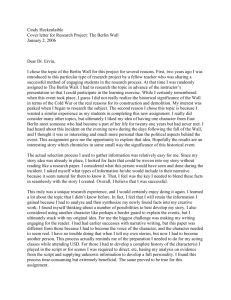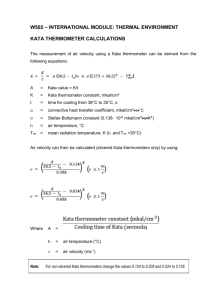Temptation - Käthe-Kollwitz
advertisement
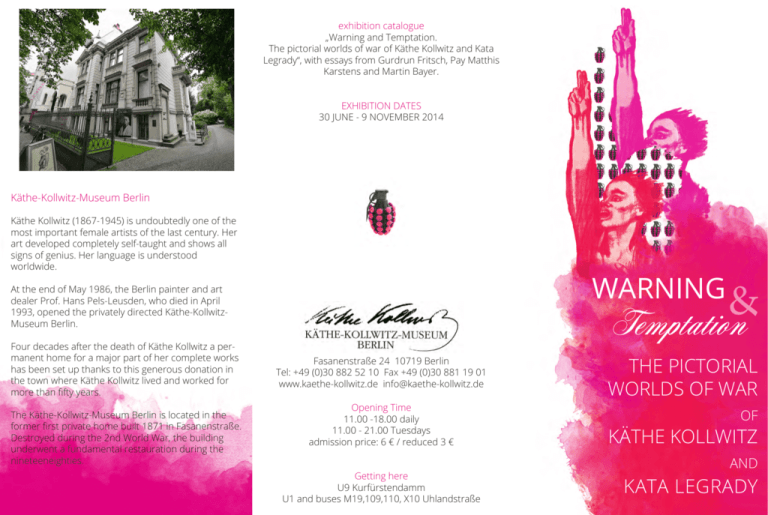
exhibition catalogue „Warning and Temptation. The pictorial worlds of war of Käthe Kollwitz and Kata Legrady“, with essays from Gurdrun Fritsch, Pay Matthis Karstens and Martin Bayer. exhibition dates 30 june - 9 November 2014 Käthe-Kollwitz-Museum Berlin Käthe Kollwitz (1867-1945) is undoubtedly one of the most important female artists of the last century. Her art developed completely self-taught and shows all signs of genius. Her language is understood worldwide. Warning & Temptation At the end of May 1986, the Berlin painter and art dealer Prof. Hans Pels-Leusden, who died in April 1993, opened the privately directed Käthe-KollwitzMuseum Berlin. Four decades after the death of Käthe Kollwitz a permanent home for a major part of her complete works has been set up thanks to this generous donation in the town where Käthe Kollwitz lived and worked for more than fifty years. The Käthe-Kollwitz-Museum Berlin is located in the former first private home built 1871 in Fasanenstraße. Destroyed during the 2nd World War, the building underwent a fundamental restauration during the nineteeneighties. Fasanenstraße 24 10719 Berlin Tel: +49 (0)30 882 52 10 Fax +49 (0)30 881 19 01 www.kaethe-kollwitz.de info@kaethe-kollwitz.de Opening Time 11.00 -18.00 daily 11.00 - 21.00 Tuesdays admission price: 6 € / reduced 3 € Getting here U9 Kurfürstendamm U1 and buses M19,109,110, X10 Uhlandstraße The pictorial Worlds of War of Käthe Kollwitz and Kata Legrady Warning and Temptation The pictorial worlds of war of Käthe Kollwitz and Kata Legrady On the occasion of the First World War’s outbreak 100 years ago, the Käthe-Kollwitz-Museum Berlin brings into focus not only the war related works of its eponym and her personal fate during two world wars. Furthermore, it is the starting point to initiate a fascinating dialogue between Käthe Kollwitz’s works and the provoking, alienated weapons of the contemporary Hungarian artist Kata Legrady. Separated by a time lag of nearly one century, work by both artists reflects the origins and consequences of martial conflicts. Although both pictorial worlds of war differ in form, they are connected by several intersecting points of content: Kata Legrady’s embellished military equipments show war’s propagandistic promises, whilst Käthe Kollwitz’s late oeuvre bemoans their tragic human consequences. Together both visual worlds bare the dualism of every war situation: bitter warnings referring to past suffering are always standing opposed to national, political and financial temptations. Kata Legrady, rocking horse, 2011, varnished beech, private property „My continuing controversial attitude to war. How has this come to pass? Through Peter´s self-sacrifice. What became clear to me at that time and what I wanted to retain in my work - all this now seems again so uncertain to me. I believed that I could only remember Peter if I did not allow myself to evade what he taught me at that time. The war has lasted for two years now and five million young men are dead and the same million human beings have been made unhappy and destroyed. Is there anything that can still justify this?“ Käthe Kollwitz in her diary, 27 August1916 Sabine Steinke, 1914/1918, 2014, private property Young generation’s perspective The artistic dialogue of generations about war and peace is further pursued by local students, who have created artworks during a museum educational project with Berlin schools. They especially emphasize Käthe Kollwitz as mother and grandmother, who did not only lose her son Peter in World War I, but also her grandson Peter (named after his dead uncle) in World War II. Due to this fact, she repeatedly tried to warn the youngest generation. Käthe Kollwitz, The Volunteers (from the series „War“), 1921/22, woodcut, Käthe-Kollwitz-Museum Berlin
